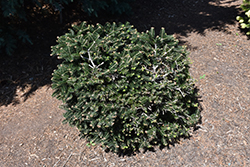Meyer's Dwarf Greek Fir
Abies cephalonica 'Meyer's Dwarf'
Height: 3 feet
Spread: 6 feet
Sunlight:
![]()
![]()
Hardiness Zone: 5
Other Names: Grecian Fir
Description:
A low maintenance garden shrub with short, dense green needles on a low spreading shrub, an excellent plant for massing, or as a rock garden specimen; particular as to siting
Ornamental Features
Meyer's Dwarf Greek Fir is a dwarf conifer which is primarily valued in the garden for its broadly spreading habit of growth. It has attractive dark green evergreen foliage which emerges light green in spring. The needles are highly ornamental and remain dark green throughout the winter.
Landscape Attributes
Meyer's Dwarf Greek Fir is a dense multi-stemmed evergreen shrub with a ground-hugging habit of growth. Its average texture blends into the landscape, but can be balanced by one or two finer or coarser trees or shrubs for an effective composition.
This is a relatively low maintenance shrub, and should not require much pruning, except when necessary, such as to remove dieback. It has no significant negative characteristics.
Meyer's Dwarf Greek Fir is recommended for the following landscape applications;
- Accent
- Mass Planting
- Rock/Alpine Gardens
- General Garden Use
Planting & Growing
Meyer's Dwarf Greek Fir will grow to be about 3 feet tall at maturity, with a spread of 6 feet. It tends to fill out right to the ground and therefore doesn't necessarily require facer plants in front. It grows at a slow rate, and under ideal conditions can be expected to live for 60 years or more.
This shrub does best in full sun to partial shade. It does best in average to evenly moist conditions, but will not tolerate standing water. It is not particular as to soil pH, but grows best in sandy soils. It is somewhat tolerant of urban pollution, and will benefit from being planted in a relatively sheltered location. Consider applying a thick mulch around the root zone in winter to protect it in exposed locations or colder microclimates. This is a selected variety of a species not originally from North America.
